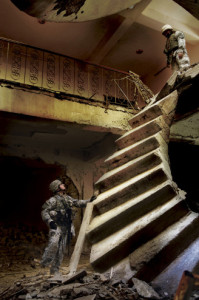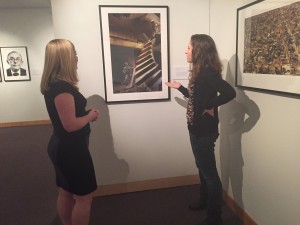Graduate student serves as curator for exhibit in the SUArt Galleries; Pearsall will photograph university and community veterans Nov. 4 and 5 as part of her Veterans Portrait Project
By: Jordan Robinson

Shadow and light play tricks on the walls of the dimly lit Syracuse University Art Galleries. The weight of mixed emotions linger over the room like an ominous cloud. A soldier looks up a winding and broken staircase to his comrade, who peers back with a look of bewilderment in his eyes. The sun sets as a soldier is being medically evacuated after being blown up by an improvised explosive device in Baghdad, Iraq. The wild eyebrows of an eighty-year-old WWII veteran lend tangibility to an era fraught with confusion and angst. All the eyes in these images have something in common: they’ve seen hardship.
Looking through the Stacy Pearsall gallery exhibit titled “Hard Earned: The Military Photographs of Stacy Pearsall” with Theresa Moir, Art History and Museum Studies graduate student and curator of the exhibition, I could feel the solemnity and emotions pouring from these images. As curator, Moir was responsible for selecting, researching, and arranging the photos currently on display in the SUArt Galleries in the Shaffer Art Building: October 6, 2015 – January 24, 2016. Through countless hours of research, she was effectively able to provide context to the photographs and make decisions as to what should be displayed. When asked how she decided which photos to include in the exhibit, she said, “I wanted to be authentic to the artist, true to her work, and true to her style. I noted [Pearsall’s] balanced compositions and use of light and shadow, and selected photographs that reflected those elements.”
Much of Stacy Pearsall’s work is dark, but not in the sense of violence. The collection from her deployments is one that inspires feelings of anxiety, depression, resistance, and despair, mixed among other emotions such as boredom and fear. Rather than depict scenes of blood and gore, Pearsall’s vision of war is something much darker and certainly more foreboding. It applies more of a humanistic aspect to war, which forces the viewer to take a cold hard look at the realities of the people living in those moments. “I wanted to humanize what people had grown to feel was inhuman – the American soldier,” said Pearsall. She believes that the true challenge as a journalist who covers war was having the ability to convey what was unseen more than what was seen. “Trying to live through these moments, to capture the everyday in a foreign place, that was the true challenge.”
 As an Airforce combat photographer and graduate of the Newhouse Military Photojournalism Program, Pearsall has gone on to document the lives and stories of people in over 41 countries, capturing over 500,000 images in the process. Her outstanding work has led her to achieve the National Press Photographers Association award for Military Photographer of the Year twice. She is one of only two women to ever receive the award. Pearsall’s work began at the age of 17, when she enlisted in the U.S. Airforce. During her service, she first entered combat as a photographer in Iraq in 2003. Several of her images were used by the White House and senior officials to make informed decisions regarding the battle space.
As an Airforce combat photographer and graduate of the Newhouse Military Photojournalism Program, Pearsall has gone on to document the lives and stories of people in over 41 countries, capturing over 500,000 images in the process. Her outstanding work has led her to achieve the National Press Photographers Association award for Military Photographer of the Year twice. She is one of only two women to ever receive the award. Pearsall’s work began at the age of 17, when she enlisted in the U.S. Airforce. During her service, she first entered combat as a photographer in Iraq in 2003. Several of her images were used by the White House and senior officials to make informed decisions regarding the battle space.
After attending the Military Photojournalism Program at the S.I. Newhouse School of Public Communications at Syracuse University, Pearsall went on to return to war zones where she witnessed more than just tragedy. She lived it. Having lost her closest companions in battle, Pearsall knew she wanted to do something more to immortalize her fellow brothers and sisters. She began by taking portraits of soldiers at large, in the very real event that they might not come back. This was the inspiration for her Veterans Portrait Project.
While the Veterans Portrait Project began as a way to immortalize and thank veterans across all ranks and services, it also served as a sort of therapy for Pearsall. “When I started this project, I was in a really dark place in my life, recovering physically and emotionally.” For her, it was healing to take the photos of men and women who had served. She wanted to not only educate herself but to educate others, to show that people come from all walks of life and from different regions across the world.
When asked about her training at Syracuse University, Pearsall said, “I found that the training I received at Newhouse really evolved the way I approached my technique. A lot of artists have a vision to begin with, but with photography it’s hard to take that vision and match it with technical skill. I’m very thankful for my Newhouse training, as it helped me grow and learn in ways I never imagined.” The support system Pearsall found at Syracuse University was unrivaled. “The relationships I fostered in school helped me at a time when I was right out of deployment. They were like a family to me.”
Pearsall will be returning to her alma mater in early November to meet the current veterans and active duty service members of Syracuse University. An event will be held in the lobby of Newhouse 2 for Stacy to photograph current veterans of the campus community on November 4th from 10 a.m. to 2 p.m. for all student and employee veterans, and on November 5th from 9 a.m. to 11 a.m. for all other veterans in the community who wish to have their picture taken. Following the event, Stacy will give each veteran a high-resolution file of their photo. She may even decide to use some of the portraits taken for her Veteran Portrait Project. Free and open to the public, this event is sure to leave a lasting impression with all of her sitters.
Stacy’s photographs mean something different to each person who looks upon her work. “One thing I really enjoy about Stacy’s work is how she uses passageways and thresholds in a lot of her photographs. She has an eye for seeing the bigger picture, for capturing ways of looking through and looking past,” said Theresa Moir. To say that Stacy Pearsall has an eye for capturing a shot is an understatement. It is more of her vision that enables her to take such moving photographs. Her ability to capture emotion in non-verbal ways demonstrates her intensive knowledge of her subjects and their surroundings. According to Moir, “Every portrait and photograph Stacy takes forces you to question what you see. The photographs ask the viewers to confront difficult subject matter, and do so in a way that emotionalizes both combat and our veterans. Pearsall’s ability to provide this humanizing context is what makes her such a brilliant photographer.”
About the Author: Jordan Robinson is a Marine Corps veteran who served at American Embassies in Mozambique, Austria, and Cuba. She currently serves at the Student Veterans Organization (SVO) President of Syracuse University and is an active member of the Syracuse University Veterans Writing Group. Her dream is to become a public diplomacy officer in the Department of State in order to facilitate positive communication between nations.
